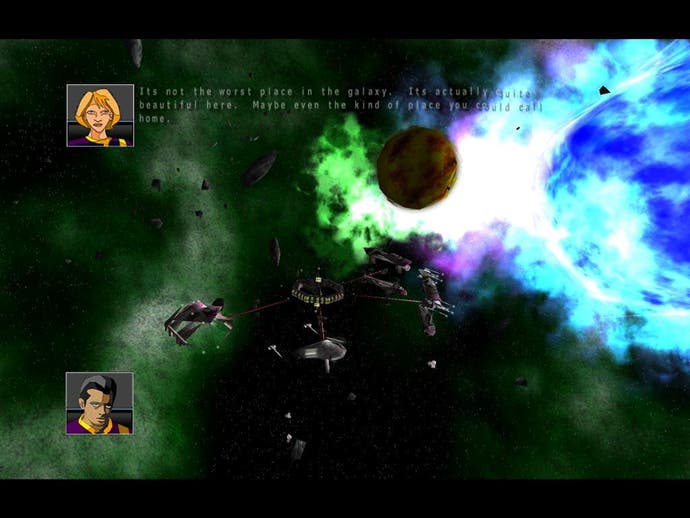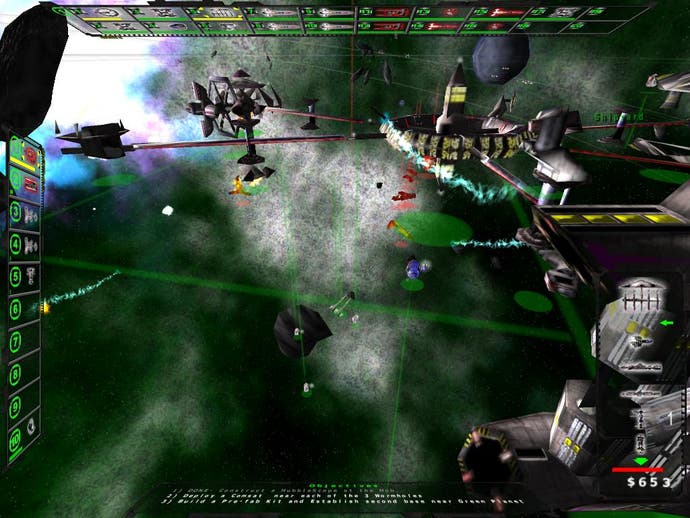FarGate
Preview - a hands-on look at the stunning Homeworld-style space strategy game
In "2001 : A Space Odyssey", Arthur C Clarke described a vision of a glorious future for mankind in which space travel was commonplace and we had permanent bases on the moon, could send men to Jupiter, and had developed an artificial intelligence all but indistinguishable from the real thing.
Now we are just two months away from the year 2001, and space travel is still the domain of a handful of wealthy governments, our first real space station is only half built, and the term AI is used to describe the usually moronic digital opponents found in most computer games. What the hell went wrong?

Alpha Centauri
FarGate is, in its own way, equally optimistic. Set around a hundred years in the future, mankind has recovered from a devestating third world war and our own solar system has been settled. Taking a leaf from "Civilization", the new world government has sent a colony ship and task force to the Alpha Centauri system. Unsurprisingly, things soon begin to go pear-shaped...
After a fifteen year voyage to our nearest neighbour, the colonists arrive to find that the supposedly habitable planet that an earlier probe discovered now has a toxic atmosphere of tri-chloro-ethane. Spending the next fifteen years travelling back to Earth isn't a particularly attractive option though, so the settlers decide to set up their pre-fab space station and explore the area to try and work out what went wrong.
The story is told entirely through in-game cutscenes, which introduce you to mission objectives and push forward the storyline without ever taking you out of the game. Cartoonish faces pop up on your screen as the various characters speak to you, and the overall effect is surprisingly immersive, although some of the voice acting could use a little work still.
The first of the game's thirty single-player missions takes the form of a tutorial, as one of the elders shows you how to control your forces and then sends you off on a reconnaissance mission. It soon becomes obvious that the Imperial Navy forces sent along with you have an ulterior motive though, and the discovery of a system of wormholes linking nearby star systems leads you into a vast conflict between alien races as you struggle to defend the other human colonists...

Visual Contact
The first thing you notice on starting up FarGate is how similar it is (on the surface at least) to Relic's excellent real-time space strategy game "Homeworld". The second thing you notice though is how gorgeous it all looks.
The game's scale is vast, with your ships moving around entire star systems, and the visuals are truly stunning. The starry background is covered in huge colourful nebulae, asteroids and lifeless moons spin their way through space, and planets surrounded by icy rings or cloaked in swirling clouds orbit around blindingly bright stars, which are themselves throwing off solar flares and massive plumes of gaudily coloured gases. Quite simply, FarGate boasts the most beautiful and active star systems that we have ever seen in any space game, regardless of genre.
The units and space stations which inhabit these star systems are also good looking, taking full advantage of transform & lighting acceleration, bump mapping and texture compression. Up close they look impressively detailed, but more distant objects become less detailed to save processing power. At times the "polygon popping" as the models switch between different levels of detail is a little distracting, but it does allow literally hundreds of units to battle it out without bringing the game to a total stand-still, and it usually isn't too obvious.

Two Tribes
Not only do the units look good, they are also fairly imaginative, and the game's two alien races certainly make a refreshing change from the humanoid creatures and big metal space ships of most computer games.
The first alien race you meet uses organic technology, and its ships include armoured jelly fish which pulse their way across space and ram your ships, giant wriggling worm-like creatures, and bizarre creatures with long tongues which grab on to your ships and drag them to their doom. Seeing an enormous tentacle suddenly emerge from an enemy space station, wrap itself around one of your battleships, and slowly reel it in as the ship's engines struggle to break free is certainly an image you won't easily forget.
The second alien race's ships look almost like gigantic ice crystals, with a whole host of them spinning through space like an out-sized blizzard as they emerge from a wormhole the first time you encounter them. The massive three way battles which occur between your human spacecraft and these giant space worms and vast crystalline structures are nothing short of spectacular, with over the top weapons effects, and smoke, flames and fluids pouring out of damaged vessels.
The explosions are amongst the most impressive we have ever seen in a game, and it's almost worth letting your space station get blown up just to admire the mother-of-all space-bound detonations, with dazzling purple, orange and white shockwaves erupting across the screen as your base vanishes amongst a blast that unfolds like a lethal flower, rapidly destroying any of your ships unfortunate enough to be in the area.

Game On
The good news is that under all of those beautiful graphics and spectacular special effects there is a great time straining to get out. The 3D camera and control system is easy to get to grips with, and ordering your ships around is easy to achieve after a little practice in the opening tutorial mission.
While Homeworld has the mothership, FarGate has a space station as the hub of your operations. This is extended throughout the game by attaching additional modules to its radial structure, and it soon starts to look like a metallic spider's web as it expands out into the surrounding space. Defensive turrets can then be bolted on to the arms that link these modules to the heart of the station, while hangars and shipyards allow you to construct everything from unarmed probes through gunships to battle cruisers. You can even build huge mining stations and secondary space stations, which have to be towed into position by tugs.
In all there are around 25 units to construct for each of the three races, and that's on top of the wide range of space station upgrades that can be built by the end of the game. If the developers can get the balance right, the diverse alien races should also make for some interesting multiplayer options, as well as providing a variety of challenges in single player mode.

Conclusion
At first sight FarGate looks very similar to Homeworld, but dig a little deeper and you'll find a game with its own unique character, with graphics which make Homeworld look positively archaic, a remarkably simple interface, and truly unique alien races with a wide selection of units to command and space station modules to construct.
The beta version we were sent was actually marked as "review code", despite the fact that the main single player campaign structure wasn't completely intact. But with the game's release just a few weeks away we are expecting to get our hands on final code soon, and will hopefully have a full review for you about the time the game hits shelves...
-
FarGate screenshots

